GM Epsilon platform
Epsilon is General Motors' mid-size front-wheel drive automobile platform. The architecture was developed by Opel, and debuted in the 2002 Opel Vectra and 2003 Saab 9-3. Since this platform falls squarely in the center of the worldwide automobile market, GM plans to produce a great many Epsilon vehicles with over a dozen variations. As of 2005, it was GM's highest volume worldwide platform. Even after the dissolution of the GM/Fiat partnership, both companies retain the rights to continue developing Epsilon-derived models.
| GM Epsilon platform | |
|---|---|
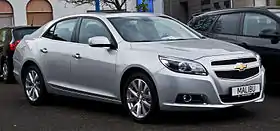 | |
| Overview | |
| Manufacturer | General Motors |
| Production | 2002–present |
| Body and chassis | |
| Class | Compact executive car (D) platform Mid-size (D) platform Large car (E) platform |
| Layout | Transverse[1] front engine, front-wheel drive/all-wheel drive |
| Body style(s) | 2-door Convertible 4-door Sedan/Saloon 5-door Hatchback/Liftback 5-door Station wagon/Estate/Caravan 5-door Multi-purpose vehicle |
| Vehicles | Buick Lacrosse/Alpheon Cadillac BLS Cadillac XTS Chevrolet Classic Chevrolet Impala Chevrolet/Holden Malibu Chevrolet Malibu Maxx Fiat Croma Opel Insignia/Buick Regal Opel Signum Opel Vectra Pontiac G6 Roewe 950 Saab 9-3 Saab 9-5 Saturn Aura |
| Related | GM Alpha platform |
| Powertrain | |
| Engine(s) | Gasoline/Petrol engines: Ecotec I4 Ecotec Family 1 I4 54° V6 High Value V6 High Feature V6 Diesel engines: Multijet I4, I5 Family B I4 Dmax V6 |
| Chronology | |
| Predecessor | GM N platform GM2900 platform GM W platform GM G platform GM Zeta Platform |
A total of 16 different models have made use of the GM Epsilon platform, some of which remain in production 17 years after the platform debuted.
Features
GM's Epsilon platform replaced the N platform in the US, and replaced the GM2900 platform elsewhere. Vehicles of this platform generally carry the symbol "Z" in the fourth digit of their VINs.
When the platform debuted, there was talk of an "Epsilon Wide" derivative, which was supposed to have provided the underpinnings for the Buick LaCrosse and Saab 9-5. However, the program was cancelled and the LaCrosse was put on the W platform, and the 9-5 was given a quick refresh for the 2006 model year.
Many of the Epsilon vehicles use the Ecotec Inline-four engines and both the High Value and High Feature V6 engines.
The refreshed 2008 SAAB 9-3 debuted with an advanced version of all-wheel-drive it dubbed XWD, finally giving a definitive answer to rumors about the platform's ability to support AWD, which had been around since the debut of the platform.
The Lambda and Theta Premium crossover platforms are derived from Epsilon.
Vehicles
Vehicles based on the Epsilon I platform:
- Regular
- 2002–2009 Opel Vectra C saloon and liftback
- 2002–2009 Vauxhall Vectra saloon and liftback
- 2002–2009 Holden Vectra
- 2002–2009 Chevrolet Vectra
- 2003–2011 and 2013–2014 Saab 9-3
- 2004–2007 Chevrolet Malibu
- 2004–2007 Chevrolet Malibu MaXX sedan and hatchback
- 2006–2009 Cadillac BLS
 Opel Vectra C
Opel Vectra C Vauxhall Vectra
Vauxhall Vectra_CD_hatchback_(2016-01-04)_01.jpg.webp) Holden Vectra
Holden Vectra.jpg.webp) Chevrolet Vectra
Chevrolet Vectra_Aero_2.8T_sedan_(2015-07-09)_01.jpg.webp) Saab 9-3
Saab 9-3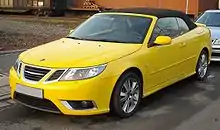 Saab 9-3 Convertible
Saab 9-3 Convertible Saab 9-3 SportCombi
Saab 9-3 SportCombi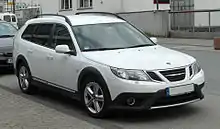 Saab 9-3X
Saab 9-3X Cadillac BLS
Cadillac BLS Cadillac BLS Wagon
Cadillac BLS Wagon Chevrolet Malibu
Chevrolet Malibu Chevrolet Malibu MaXX
Chevrolet Malibu MaXX
- Extended
- 2002–2009 Opel Vectra C Caravan
- 2002–2009 Vauxhall Vectra Caravan
- 2003–2008 Opel Signum
- 2008–2012 Chevrolet Malibu
- 2005–2010 Pontiac G6
- 2005–2011 Fiat Croma
- 2007–2010 Saturn Aura
 Opel Vectra C Caravan
Opel Vectra C Caravan Vauxhall Vectra Estate
Vauxhall Vectra Estate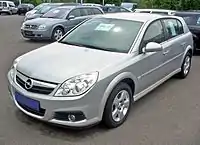 Opel Signum
Opel Signum Vauxhall Signum
Vauxhall Signum Chevrolet Malibu
Chevrolet Malibu Pontiac G6
Pontiac G6 Pontiac G6 Coupe
Pontiac G6 Coupe Pontiac G6 Convertible
Pontiac G6 Convertible Saturn Aura
Saturn Aura Fiat Croma
Fiat Croma
Cancelled vehicles which would have used this platform:
- 2006 midsized Buick
Epsilon II
A new version of the Epsilon, dubbed Epsilon II, debuted in 2008. It is adaptable for front and all-wheel drive applications. In long wheelbase format, Epsilon II supports US EPA Large Cars, allowing GM to replace the G and W platforms. The architecture was developed by Opel in Rüsselsheim, Germany. Many safety features and AWD fitment modifications were done by Saab.[2]
Current and announced vehicles built on Epsilon II:
- SWB
- 2008–2017 Opel Insignia, Vauxhall Insignia, Holden Insignia VXR, Buick Regal, Chevrolet Vectra (saloon, hatchback, estate) (SWB)
- 2012–2016 Chevrolet Malibu, Holden Malibu (SWB)
- SL LWB
- EL LWB
- 2012–2019 Cadillac XTS (EL LWB)
- 2014–2019 Chevrolet Impala (EL LWB)
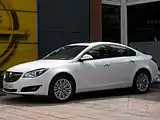 Opel Insignia
Opel Insignia Opel Insignia OPC
Opel Insignia OPC Opel Insignia Sports Tourer
Opel Insignia Sports Tourer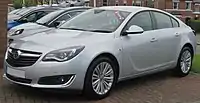 Vauxhall Insignia
Vauxhall Insignia Vauxhall Insignia Estate
Vauxhall Insignia Estate Buick Regal
Buick Regal Buick Regal GS
Buick Regal GS_VXR_sedan_(20104110092).jpg.webp) Holden Insignia VXR
Holden Insignia VXR Chevrolet Vectra
Chevrolet Vectra.jpg.webp) Buick LaCrosse
Buick LaCrosse Alpheon EL300
Alpheon EL300 Roewe 950
Roewe 950 Chevrolet Malibu
Chevrolet Malibu.jpg.webp) Chevrolet Impala
Chevrolet Impala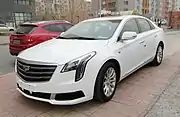 Cadillac XTS
Cadillac XTS Saab 9-5
Saab 9-5
Concept vehicles built on Epsilon II:
- 2007 Buick Riviera
- 2007 Opel GTC Concept
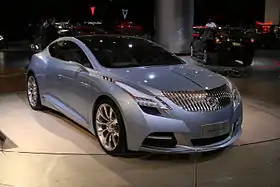 Buick Riviera Concept (2007)
Buick Riviera Concept (2007).jpg.webp) Opel GTC Concept
Opel GTC Concept
E2XX
E2XX is the successor to the Epsilon II platform. It is development of the Epsilon II platform, consistent with other platform revamps, such as the D2XX based on Delta II.
The E2XX platform targets weight reductions and longer wheelbases.
Vehicles
Vehicle built on E2XX:
- 2016–present Chevrolet Malibu
- 2017–present Opel Insignia
- 2017-present Vauxhall Insignia
- 2018–present Buick Regal
- 2018–2020 Holden Commodore (ZB)
- 2019–present Cadillac XT4
- 2021–present Buick Envision
 Chevrolet Malibu
Chevrolet Malibu.jpg.webp) Opel Insignia Grand Sport
Opel Insignia Grand Sport_%E2%80%93_Frontansicht%252C_12._Mai_2017%252C_D%C3%BCsseldorf.jpg.webp) Opel Insignia Sports Tourer
Opel Insignia Sports Tourer.jpg.webp) Opel Insignia Country Tourer
Opel Insignia Country Tourer Opel Insignia GSi
Opel Insignia GSi Vauxhall Insignia Grand Sport
Vauxhall Insignia Grand Sport Vauxhall Insignia Sports Tourer
Vauxhall Insignia Sports Tourer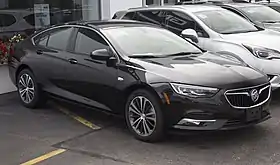 Buick Regal Sportback
Buick Regal Sportback Buick Regal GS
Buick Regal GS Buick Regal TourX
Buick Regal TourX_LT_sedan_(2018-08-06)_01a.jpg.webp) Holden Commodore (ZB)
Holden Commodore (ZB)_V6_AWD_Tourer_(2018-11-29)_01.jpg.webp) Holden Commodore (ZB) Tourer
Holden Commodore (ZB) Tourer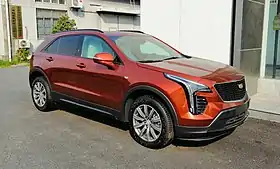 Cadillac XT4
Cadillac XT4 Buick Envision
Buick Envision
P2XX
P2XX is the longer variant of the E2XX platform.
Vehicle built on P2XX:
 Buick LaCrosse
Buick LaCrosse
C1XX
C1XX is the crossover variant of the E2XX platform, replacing the Theta Premium and Lambda platforms.
Vehicles built on C1XX:
Smaller mid-size:
- 2017–present Cadillac XT5
- 2019–present Chevrolet Blazer
- 2017–present GMC Acadia
- 2018-2020 Holden Acadia
 Cadillac XT5
Cadillac XT5 Chevrolet Blazer
Chevrolet Blazer GMC Acadia
GMC Acadia.jpg.webp) Holden Acadia
Holden Acadia
Larger mid-size:
- 2018–present Buick Enclave (China)
- 2020–present Cadillac XT6
- 2019–present Chevrolet Blazer (China)
 Buick Enclave
Buick Enclave Cadillac XT6
Cadillac XT6 Chevrolet Blazer
Chevrolet Blazer
Full size:
- 2018–present Buick Enclave
- 2018-present Chevrolet Traverse
 Buick Enclave
Buick Enclave Chevrolet Traverse
Chevrolet Traverse
Footnotes
- https://www.autoevolution.com/news/general-motors-vehicle-platforms-explained-from-the-gamma-to-the-all-new-gm-omega-platform-93953.html
- Meiners, Jens (May 2009). "Spied: 2010 Saab 9-5". Car and Driver. Hearst Magazines. Retrieved 2013-05-05.
- Sutcliffe, Ashley (12 April 2012). "Roewe | Roewe 950 hits the market, priced competitively". chinacartimes.com. China Car Times – China Auto News. Archived from the original on 3 December 2012. Retrieved 2 October 2012.
References
- Kranz, Rich (April 12, 2005). "GM lagging behind in booming sport wagon market". AutoWeek. Retrieved April 12, 2005.
- Smith, Mike (March 1, 2014). "2014 Chevrolet Malibu Safety Cage". Retrieved March 1, 2014.